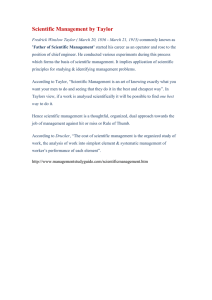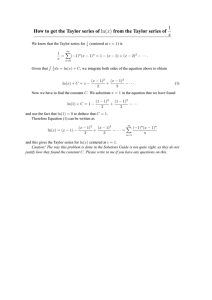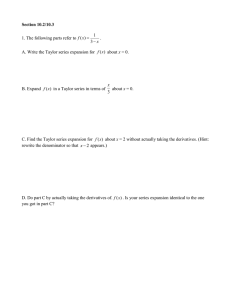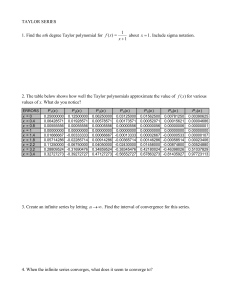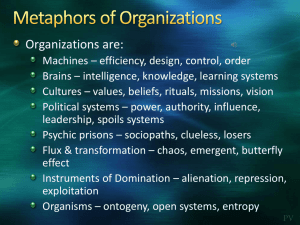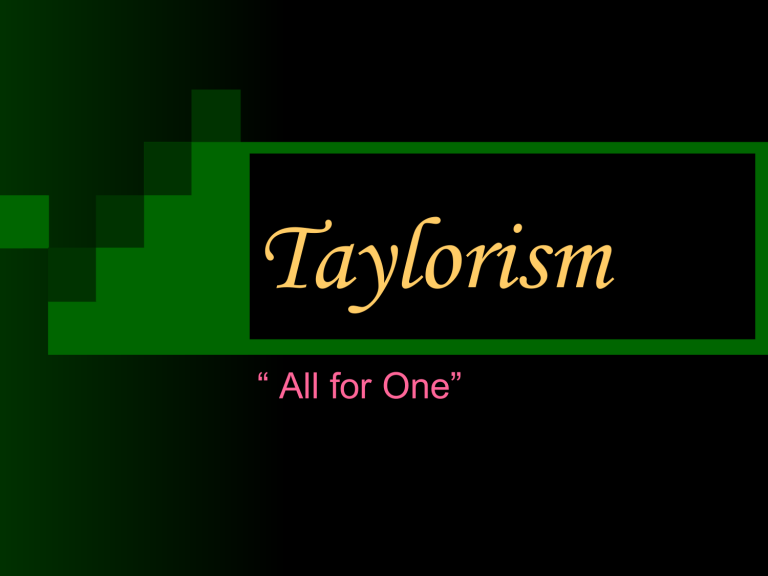
Taylorism “ All for One” An Introduction… Frederick Winslow Taylor (20 March 1856– 21 March 1915), widely known as F. W. Taylor, was an American mechanical engineer who sought to improve industrial efficiency. He is regarded as the father of scientific management, and was one of the first management consultants. EQUITABLE ATTITUDE: "The old fashioned dictator does not exist under Scientific Management. The man at the head of the business under Scientific Management is governed by rules and laws which have been developed through hundreds of experiments just as much as the workman is, and the standards developed are equitable." SOLDIERING: More Productivity Fewer requirement Elimination of jobs. Non Incentive Wage system i.e. Payment was regardless of Productivity. Workers relied more on rule of thumb methods rather than on optimal scientific methods. To scientifically determine the optimal way to perform a job, Taylor performed experiments that he called time studies, (also known as time and motion studies). These studies were characterized by the use of a stopwatch to time a worker's sequence of motions, with the goal of determining the one best way to perform a job. Following are examples of some of the time-and-motion studies that were performed by Taylor: 2) 3) 4) Pig Iron The Science of Shoveling Bricklaying The assumptions underlying his work were: The presence of a capitalist system and a money economy, where companies in a free market have as their main objective the improvement of efficiency and the maximization of profit; 2) The Protestant work ethic, that assumes people will work hard and behave rationally to maximize their own income, putting the perceived requirements of their organization before their own personal objectives and goals; 3) That an increased size is desirable in order to obtain the advantages of the division of labour and specialization of tasks. 3) KEY FUNDAMENTALS OF TAYLORISM: Mass production methods Division of labour PRINCIPLES OF TAYLOR: Replace rule-of-thumb work methods with methods based on a scientific study of the tasks. Scientifically select, train, and develop each employee rather than passively leaving them to train Cooperate with the workers to ensure that the scientifically developed methods are being followed. themselves. Divide work nearly equally between managers and workers, so that the managers apply scientific management principles to planning the work and the workers actually perform the tasks. According to Taylor, Management should :establish specific work targets pay workers for the tasks and goals met, and provide regular feedback. The main elements of his theory were:- 1.Management is a true science. The solution to the problem of determining fair work standards and practices could be discovered by experimentation and observation. From this, it follows, that there is "one right way" for work to be performed. 2. The selection of workers is a science. Taylor's "first class worker" was someone suitable for the job. It was management's role to determine the kind of work for which an employee was most suited, and to hire and assign workers accordingly. 1.Workers are to be developed and trained. It is management's task to not only engineer a job that can be performed efficiently, but management is responsible for training the worker as to how the work is to be performed and for updating practices as better ones are developed. This standardizes how the work is performed in the best way. 4. Scientific management is a collaboration of workers and managers. Managers are not responsible for execution of work, but they are responsible for how the work is done. Planning, scheduling, methods, and training are functions of the manager. Taylor's scientific management consisted of four principles: 1.Replace rule-of-thumb work methods with methods based on a scientific study of the tasks. 2.Scientifically select, train, and develop each employee rather than passively leaving them to train themselves. 3.Provide "Detailed instruction and supervision of each worker in the performance of that worker's discrete task" (Montgomery 1997: 250). 4.Divide work nearly equally between managers and workers, so that the managers apply scientific management principles to planning the work and the workers actually perform the tasks These principles were implemented in many factories, often increasing productivity by a factor of three or more. Henry Ford applied Taylor's principles in his automobile factories, and families even began to perform their household tasks based on the results of time and motion studies. His framework for organization was: Clear delineation of authority responsibility separation of planning from operations incentive schemes for workers management by exception task specialization PROBLEMS DUE TO TAYLORISM: 1) 2) 3) It lead to some unscrupolous practices like Rate Cutting. In 1911-12, the US House of Representatives passed a law banning use of stopwatches. It assumes that human beings are like machines and workers are satisfied by money alone. Taylor's impact has been so great because he developed a concept of work design, work-measurement, production control and other functions, that completely changed the nature of industry. Before scientific management, such departments as work study, personnel, maintenance and quality control did not exist. What was more, his methods proved to be very successful. A Brief Review Taylor’s theories were based on a simple interpretation of human behaviour, that people are motivated solely by money – his term was “rational man” The 4 main principles of the Taylor system Scientific task design Scientific selection Management-worker co-operation Equal division of work Ford’s Model T The assembly line: A number of small technical changes and more extensive use of the assembly line allowed Ford to raise wages to 5 dollars a day. Originally manufactured in 1909, by 1926, Ford lowered the price of the Model T to $300. Smart Shoveling Taylor experimented with the shape, size, and weight of shovels to determine the impact on productivity. His experiments showed that no one shovel was best for all materials. By designing task-specific shovels, Taylor tripled the amount of material a worker could shovel in a day. This dramatically improved morale as well since workers were paid by the ton. Increasing productivity meant increasing income. A relic of the past??? Taylorism may have been good during the industrial revolution, but not so much in the technology revolution. Automation has resolved many problems which Taylor sought to address. The man power requirement has been lowered. How so? Each worker was a cog in the wheel. He could not do without the wheel, but wheel could easily replace him. They became replaceable and de-skilled. But in these times, skilled workers are required to operate machines. Result: A few skilled workers’ earnings increase, the rest are booted out, unemployment increases. Repetition is Ennui: It was assumed that due to worker specialisation of repeated tasks, productivity would increase. One of Taylor's aims was the drive for cheaper labour costs, which was to be achieved through deskilling and rationalization of the workforce. This also involved reducing the industrial muscle of the workforce. “I know what you had to do last hour…” These measures meant that management increased control over production costs, furthermore, Taylorist techniques aimed to make managers solely responsible for organising and directing work, as it was considered if the tasks were to be carried out efficiently the workers had to follow managerial directions exactly. “Separating planning from doing" The performance of the tasks was to be carried out by the workers but all the aspects of planning were to be taken over by management. If the workforce was left to plan its own work, both efficiency and production would fall. Who gets more leverage? With a reduction in the skill level of tasks, the market power of groups and individuals meant employees had less leverage over negotiations with employers “K.I.S. is not always the best option…” Absolute belief that de-skilled workforce allowing themselves to be led without question by management, accepting any task they are asked to perform. Taylor has a tendency to over-simplify the relationship between the employer and the workforce, seeing it as largely based on the production line. “Fair day's pay for a fair day's work" This is constantly under review by both the workforce and management. Also the price of labour may be determined by external factors such as scarcity, product demand and economic conditions within the country, all out of the direct control of management. Unrealistic? The managers are looked upon as having unwavering loyalty towards the company. Taylorism denies the fact that managers can chose from a variety of strategies and in many cases can be flexible in their approach to the workforce. Socialism pro-Taylorism? Lenin believed in and applied Taylorist techniques to Russian industry. Scientific management provided the worker discipline, control and methodology that was accepted by the communist world. Think “ centralization”. Power rests with the management. “Responsible Autonomy" Through responsible autonomy, the workforce are given a degree of independence once they have been made aware of the importance of their tasks and performance. One of the aims is to keep supervision to a minimum and yet maintain overall control. Paternalism: Large corporations can take advantage of the dependency of employees on the company by offering incentives such as free medical insurance or free private schooling for families of employees. If employees leave or produce unsatisfactory work, the benefits can be withdrawn. Wakon Yosai Scientific Management was introduced into Japanese industry on a wide scale in the inter-war years. Taylorism became an important factor in the creation of what has been held by some observers to be a uniquely Japanese system of organization and management Japanese employers set out to build organizational cultures, involving high levels of worker commitment, and flexibility, in the inter-war period within for example the cotton textile industry. But he really believed in his ideas… To his very death he maintained that, “The major beneficiary of fruits of productivity has to be the worker and not the owner.” “The new way is to teach and help your men as you would a brother; try to teach him the best way and show him the easiest way to do his work.” -- Frederick Winslow Taylor “Organizing is the art of achieving extraordinary things with ordinary people.” Thank You
